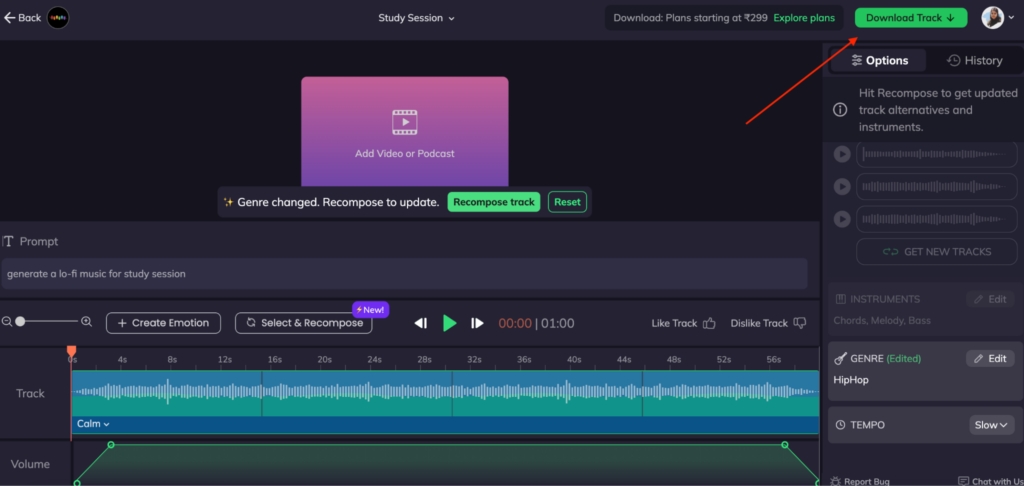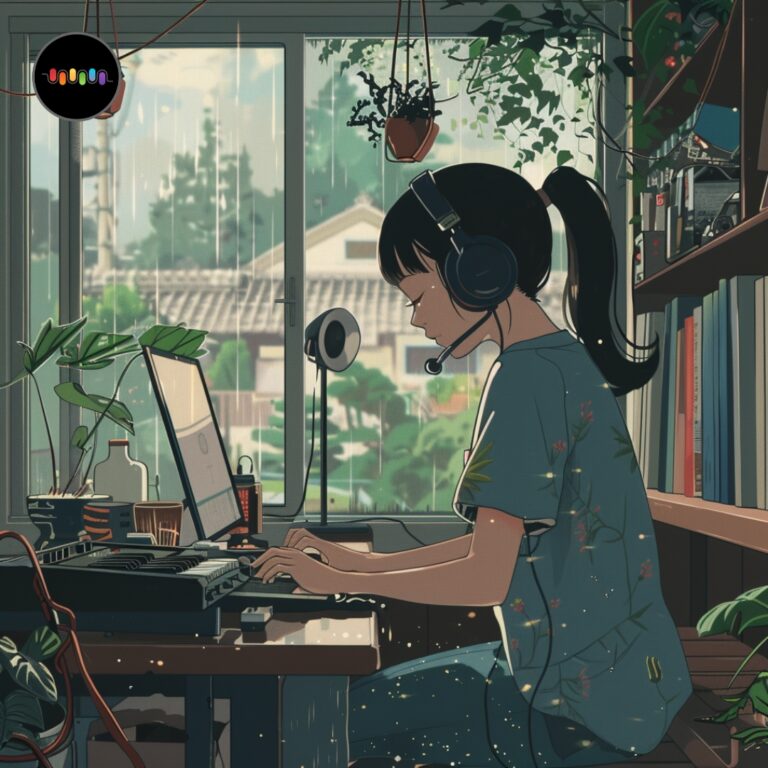Hearing the term “Lo-fi music” a lot lately, but not sure what it is. Lo-fi music is that escape from regular music where musicians don’t put in a lot of effort to make it a sophisticated, polished track you normally hear.
It is more about letting it loose and producing music that features real elements.
Lo-fi music has been receiving a lot of attention lately. By the time you read this piece, most of your favorite songs will likely already have a lo-fi version.
If you are a content creator or music enthusiast looking to strategically use lo-fi music in your content, we have you covered.
We have prepared a detailed guide on lo-fi music that will take you through its features, sub-genres, and creation process.
What is Lo-Fi Music?
Lo-fi music, aka Low-fidelity music, is the type of music that’s not refined with high-quality studio recordings. Lo-fi music is all about embracing the raw, authentic aspects associated with any music. This could be conversations, birds chirping, or even the traffic noise in the background.
Creators who want to give their content a laid-back and natural vibe prefer lo-fi music. Listen to the music featured on this channel called Lofi Girl. You will see that each video features a different lo-fi music aimed at completing various types of activities, be it studying, relaxing, going on a journey, gaming, and so on. A certain calmness and nostalgia are associated with each piece of music, even though it is not “perfectly” recorded.
Lo-Fi Music – History and Background Story
The history of Lo-Fi music goes back to the 2000s. J Dilla and Nujabes are known as the godfathers of Lo-fi music. Japanese artist Nujabes’ use of lo-fi music for the anime Samurai Champloo is considered one of the first and most revolutionary uses of Lo-fi music. US rapper and producer J Dilla is also remembered for his greatest contributions to the popularity of lo-fi music.
In the 2010s, lo-fi music became extremely popular when popular YouTubers like Lofi Girl (Then ChilledCow) started using it in their videos and YouTube live streams. The popularity continued in the 2020s as more and more YouTube creators like Joey Pecoraro, Eevee, and Jinsang rose to fame for their soothing lo-fi music.
Top Features of Lo-fi Music
Want to distinguish lo-fi beats from conventional music? Here are the lo-fi music features you must know:
Since interactive elements are a critical part of lo-fi music and add authenticity, drum loops are often extensively used to form the underlying rhythm of lo-fi music.
Lo-fi music should sound simple yet smooth with that jazzy feel to it. That’s why you will find many jazz chords in any lo-fic music. A familiar favorite of jazz players is to keep the beats soothing and optimistic, and including jazz chords brings that feel forward. Some musicians also use horns and guitars, depending on the composition.
Lo-fi beats do not involve a lot of background noise, so you don’t even hear the actual music. But they certainly have all the must-have elements of a regular atmosphere. There is no specific way to add atmospheric elements to a lo-fi track.
In fact, it can be anything—the sound of a car, airplane, television playing in the background, kids playing at a distance, and so on. Make sure to keep it distinct, smooth, and distant. While atmospheric elements make lo-fi beats unique, they should be added in the right amount so they don’t affect the overall music experience.
Lo-fi music tracks are instrumental beats. However, some lo-fi music also includes vocal samples and effects from other supporting tracks. These samples break the monotony and introduce the nostalgia of analog recording.
Why is Lo-Fi Music more Popular than Ever? Benefits of Lo-fi Music
Lo-fi music is relaxing and leaves a significant impact on the listeners. Lofi Girl, a pioneer of lo-fi music on YouTube, has an average monthly view of 1.92 billion views. This can be a testament to the effectiveness of lo-fi beats on listeners.
Some of the key reasons behind its popularity are:
Lo-fi music’s soothing beats and rhythms have an instant relaxing impact on your brain. Therefore, whether you are trying to study that chapter, read a book, focus on a DIY project, or simply be in the mood to clean up your space, lo-fi beats help you concentrate by setting the mood.
With minimal lyrics and repetitive rhythms, lo-fi music is believed to engage you for a long time in whatever activity you are doing.
Though it originated in the 2000s, lo-fi music has roots in the 1980s and 1990s. Packed with powerful emotions, it creates a sense of nostalgia, especially for millennials and GenZs who have briefly lived in that era or have heard stories of it.
Music that is good to the ears is certainly memorable. But music that triggers powerful emotions and profoundly connects with the listener is bound to have a more significant impact. Lo-fi music does precisely that.
Lo-fi music takes an unconventional approach. Its production, minimalistic lyrics, use of raw instruments, and free recording styles make lo-fi beats unique and set them apart from conventional, high-fidelity, sophisticated music.
Authenticity sells on social media, and that’s partly why Instagram, YouTube, TikTok, Twitter, and even LinkedIn are promoting personal stories and real-life experiences over the same-old shorts, videos, and reels.
Lo-fi music is the foundation of raw, uncut videos due to its experimental instrumentation and the creative usage of noises.
Top Lo-Fi Sub-genres You Must Know
Since lo-fi music differs from regular music, its sub-genres are also atypical. Here are the trending sub-genres of lo-fi music that you must know of:
Lo-fi hip-hop
Originating from the 90s hip-hop music, Lo-fi hip-hop music consists of many drums, chords, and atmospheric textures. The “Godfathers of lo-fi music,” J Dilla and Nujabes, were both practitioners of lo-fi hip-hop.
Here is an example of lo-fi hip hop👇
Chillhop
Chillhop is close to hip-hop but with a laid-back version of it. Chillhop typically includes lots of tempos and soundscapes. Lo-fi chillhop is perfect for study sessions or when you don’t want to do anything.
Here is an example of lo-fi chillhop👇
Lo-fi house
This type of lo-fi music compiles house aesthetics and elements generated through low-resolution drum samples and synthesizers. This music sub-genre has the warmth of analog music with a mix of danceable sounds.
Here is an example of lo-fi house👇
Lo-fi indie rock
If you like jangling guitar sounds and clanky drum beats, you will love lo-fi indie rock.
Here is an example of lo-fi indie rock👇
Lo-fi Synthwave
This sub-genre of lo-fi music is focused on faded sound and lyrics, and it is very similar to retro pop.
Here is an example of lo-fi synthwave👇
Steps to Create Lo-Fi Music
Creating lo-fi music using an AI music generator is now easier than ever! Below are the steps:
Step 1: Type a prompt of your choice
Use an AI music generator like Beatoven.ai. The first step is to type a prompt about the type of lo-fi music you are willing to generate. The more comprehensive your prompt is, the better your chances of generating the music you are looking for. Once you add the prompt, the tool automatically captures the genre.
Our prompt was simple: to generate a lo-fi beat for a study session.

Step 2: Download your royalty-free lo-fi music
Now your lo-fi music is ready. You just need to download it. The best part is it is 100% royalty-free. You can use this track as often as necessary without worrying about copyright strikes.

Conclusion
We hope that you know what lo-fi music is, how to use it, and most importantly, how to create it.
The next step is to create your first lo-fi music, and Beatoven.ai is where you can get started.
FAQs
Lo-fi music enhances focus, creates a suitable ambiance for various tasks, and evokes nostalgia. Its distinctive, unpolished, and genuine sound distinguishes it from traditional music.
Use an AI music generator such as Beatoven.ai. Input a prompt, select a sub-genre, and obtain royalty-free lo-fi music.
Lo-fi (low-fidelity) music is not polished with professional studio recordings. It incorporates the raw, genuine elements associated with music, including ambient sounds.
Lo-fi music’s calming rhythms and sparse lyrics aid in concentration and provide the ideal environment for studying.
Lo-fi music’s calming effect, nostalgic feel, and distinct, authentic sound have increased popularity, particularly among millennials and Gen Zs.

Sreyashi Chatterjee is a SaaS content marketing consultant. When she is not writing or thinking about writing, she is watching Netflix or reading a thriller novel while sipping coffee.

